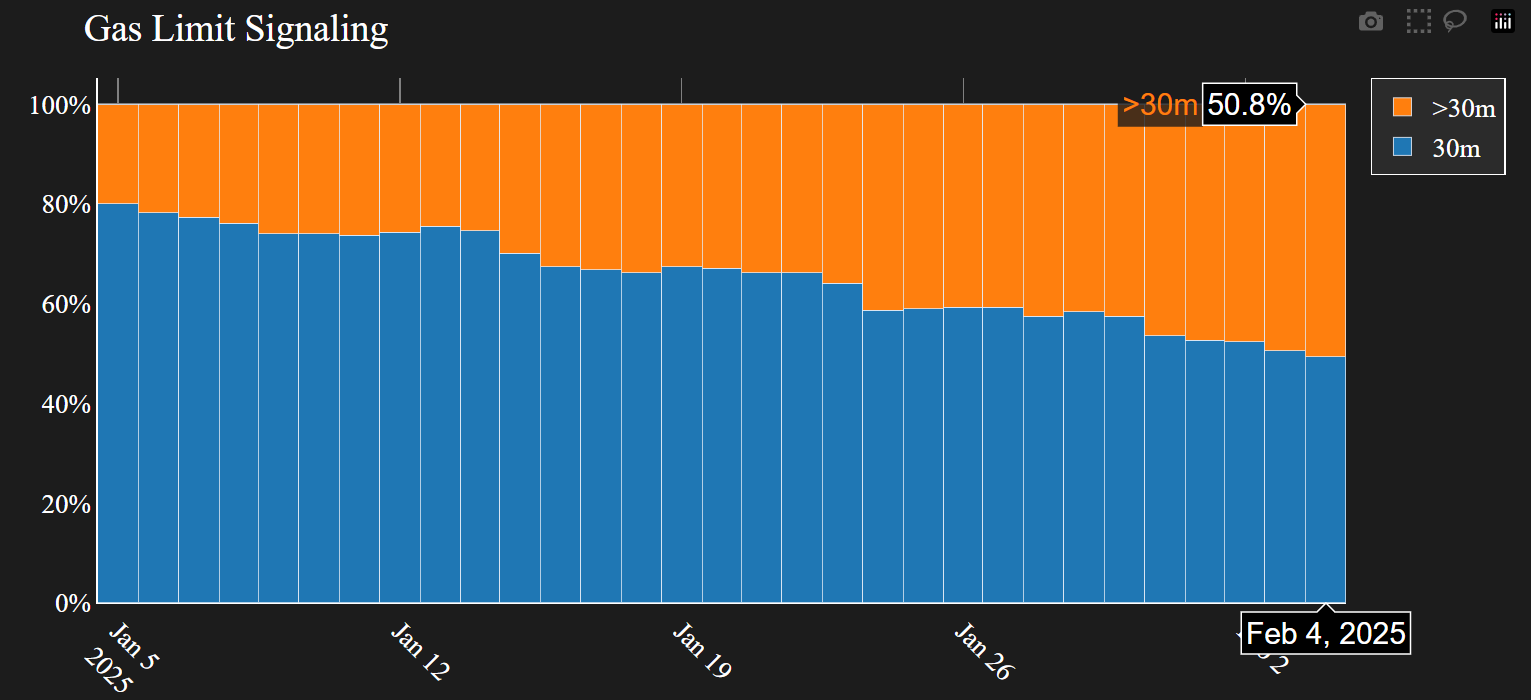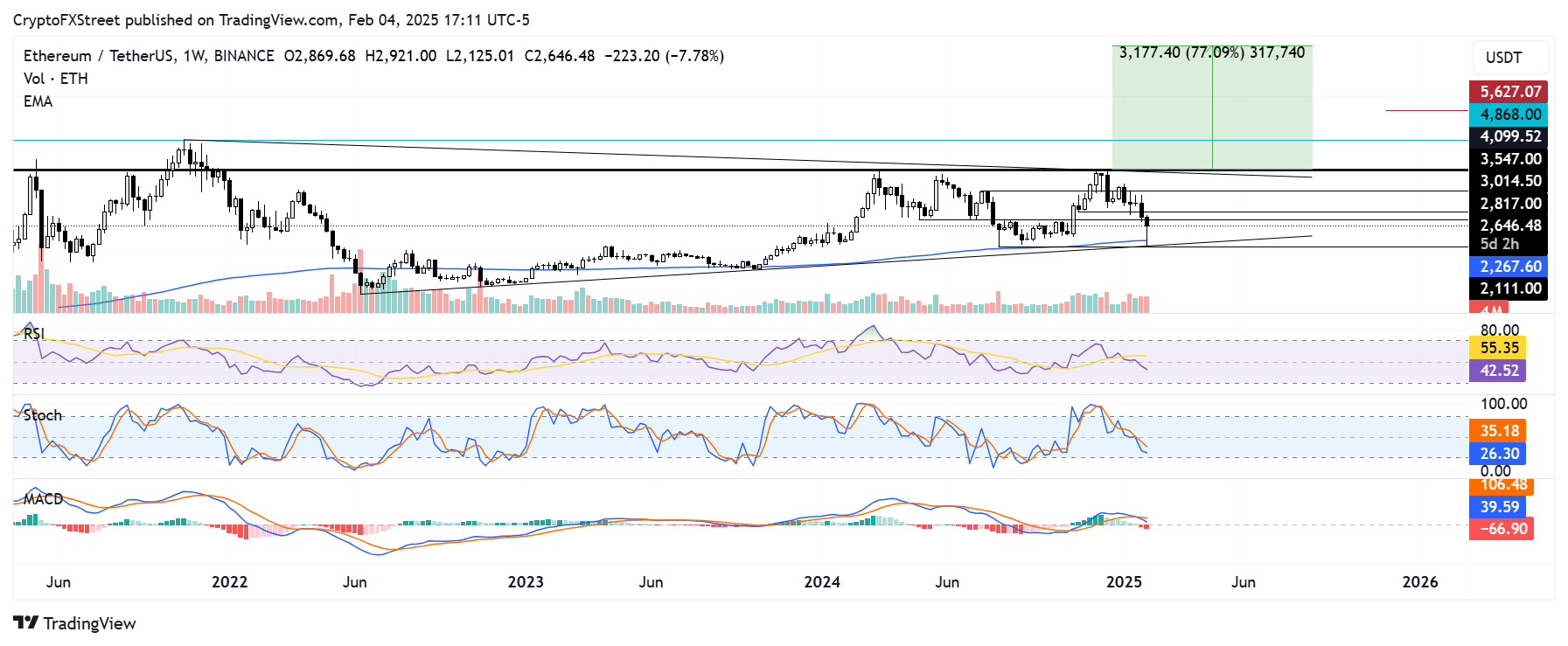Ethereum price today: $2,670
- Ethereum validators reached a consensus to increase the network’s gas limit above 30 million units to improve scalability.
- Ethereum buying activity has increased since the market crash, with ETH ETFs taking in $83 million and exchange reserves plunging by over 250,000 ETH.
- ETH sees rejection near the $2,800 to $3,000 key zone as potential breakout from a symmetrical triangle could determine its price trajectory.
Ethereum (ETH) is down 7% on Tuesday after validators reached a consensus to increase the network’s gas limit above 30 million. Meanwhile, investors have been scooping up ETH since the market crash with rising buying activity across ETH exchange-traded funds (ETFs) and crypto exchanges.
Ethereum gas limit increase and Pectra upgrade to improve network scalability
Ethereum’s gas limit increased to 32 million in several blocks in the past 24 hours, with over 50% of validators reaching a consensus to remove the limit of 30 million units and improve scalability.
The upgrade didn’t require a hardfork as it automatically became standard after over half of the network’s validators signaled support for the change by updating their nodes, according to data from gaslimit.pics.

Gas Limit Signaling. Source: GasLimit.Pics
Gas is the unit used to measure the monetary value of computational efforts to process transactions on Ethereum. The gas limit represents the total transaction capacity that can be included in a block.
Ethereum’s gas limit has been over 30 million per block in the past few hours, meaning more transactions can be included in a block, or heavily computational transactions can see quicker settlement times.
The gas limit upgrade marks the first change to the network’s gas standard since the transition to the Proof-of-Stake consensus mechanism.
Following the upgrade, Ethereum co-founder Vitalik Buterin commended developers working on solutions to improve the Ethereum mainchain.
He also highlighted that the upcoming Pectra upgrade in March will boost the scalability of Layer 2 (L2) networks by increasing the blob target within Ethereum blocks from three to six. Blobs are temporary storage units in Ethereum blocks for storing L2 transactions.
Pectra, expected in March, will increase the blob target from 3 to 6, doubling the capacity of L2s.
IMO we should make the blob target also staker-voted, so that it can increase in respose to technology improvements without waiting for hard forks.
— vitalik.eth (@VitalikButerin) February 4, 2025
Meanwhile, Ethereum saw increased buying activity following the market crash on Monday.
US spot Ethereum ETFs recorded net inflows of $83.60 million on Monday, per Coinglass.
On the traditional crypto market, investors withdrew over 250,000 ETH from exchanges in the past two days, according to CryptoQuant’s data.
Ethereum Price Forecast: ETH has to break out of symmetrical triangle to determine its next trend
Ethereum sustained $156.08 million in futures liquidations in the past 24 hours, per Coinglass data. The total amount of long and short liquidations accounted for $65.13 million and $90.95 million, respectively.
On the weekly chart, Ethereum found support at the lower boundary line of a symmetrical triangle pattern following the recent market decline. The top altcoin aims to recover the $2,800 to $3,000 key zone but faces rising selling pressure after seeing a rejection.

ETH/USDT weekly chart
A firm weekly candlestick close below the lower boundary line of the symmetrical triangle could spark a massive bearish trend for ETH.
However, a high volume weekly candlestick close above the $4,100 resistance could see ETH pull off a mega rally to reach a new all-time high of $7,000. The target is obtained by measuring the distance between the triangle’s lowest and highest point, and projecting it upward from a potential breakout level.
The Relative Strength Index (RSI), Stochastic Oscillator (Stoch) and Moving Average Convergence Divergence (MACD) histogram are below their neutral levels, indicating dominant bearish momentum.
Ethereum FAQs
Ethereum is a decentralized open-source blockchain with smart contracts functionality. Its native currency Ether (ETH), is the second-largest cryptocurrency and number one altcoin by market capitalization. The Ethereum network is tailored for building crypto solutions like decentralized finance (DeFi), GameFi, non-fungible tokens (NFTs), decentralized autonomous organizations (DAOs), etc.
Ethereum is a public decentralized blockchain technology, where developers can build and deploy applications that function without the need for a central authority. To make this easier, the network leverages the Solidity programming language and Ethereum virtual machine which helps developers create and launch applications with smart contract functionality.
Smart contracts are publicly verifiable codes that automates agreements between two or more parties. Basically, these codes self-execute encoded actions when predetermined conditions are met.
Staking is a process of earning yield on your idle crypto assets by locking them in a crypto protocol for a specified duration as a means of contributing to its security. Ethereum transitioned from a Proof-of-Work (PoW) to a Proof-of-Stake (PoS) consensus mechanism on September 15, 2022, in an event christened “The Merge.” The Merge was a key part of Ethereum’s roadmap to achieve high-level scalability, decentralization and security while remaining sustainable. Unlike PoW, which requires the use of expensive hardware, PoS reduces the barrier of entry for validators by leveraging the use of crypto tokens as the core foundation of its consensus process.
Gas is the unit for measuring transaction fees that users pay for conducting transactions on Ethereum. During periods of network congestion, gas can be extremely high, causing validators to prioritize transactions based on their fees.

























